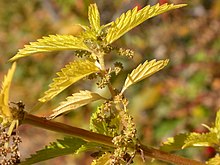

|
Started subsecies, moved information about former species to table.
|
m Moving Category:Flora of North AmericatoCategory:Flora of Northern America per Wikipedia:Categories for discussion/Log/2023 June 7#Category:Flora of Central Europe
|
||
| Line 61: | Line 61: | ||
[[Category:Urtica|gracilis]] |
[[Category:Urtica|gracilis]] |
||
[[Category:Flora of |
[[Category:Flora of Northern America]] |
||
[[Category:Plant subspecies]] |
[[Category:Plant subspecies]] |
||
| Urtica gracilis | |
|---|---|

| |
| Scientific classification | |
| Kingdom: | Plantae |
| Clade: | Tracheophytes |
| Clade: | Angiosperms |
| Clade: | Eudicots |
| Clade: | Rosids |
| Order: | Rosales |
| Family: | Urticaceae |
| Genus: | Urtica |
| Species: |
U. gracilis
|
| Binomial name | |
| Urtica gracilis (Aiton) | |
| Synonyms[1] | |
| |
Urtica gracilis, commonly known as the slender nettle, tall nettle, or American stinging nettle, is a perennial plant plant without woody stems that is well known for the unpleasant stinging hairs on its leaves and stems.[2] It is native to much of the North America from Guatemala northwards and temperate areas of South America.[1] It is easily confused with the visually very similar Eurasian species Urtica dioica and is still listed in some resources as a subspecies of this plant. However, genetic analysis and experiments show that they are genetically distinct.
Urtica gracilis is a perennial plant, one that regrows for many years, with stems that die back the ground in winter (herbaceous plant).[3] It spreads both by wind borne seeds and by rhizomes, often forming dense stands in favorable conditions.[2] Plants can be between 50 centimeters and 3 meters in height with stems that can be simple or branched.[3] Stems will vary in between being smooth and covered in stiff hairs (glabroustostrigose), but have few of the stinging hairs the plant is known for.[4]
The leaves of Urtica gracilis are variable, elliptic, lanceolate, or ovate, and 6–20 cm long by 2–13 cm across, with a base that can either be rounded or shaped like a heart (roundedtocordate). The leaf edges are have coarse teeth, sometimes with smaller teeth within each larger tooth (doubly serrate) and the ends are pointed.[3] The underside of the leaves are covered in the stinging hairs that the species is so well known for, but the upper surface only rarely has a few stinging hairs and is more often smooth or covered in non-stinging fine hairs (puberulent).[4]
Urtica gracilis has a flowering panicle, a much branched flowering stem with multiple flowers on sort stems. The flowers are unisexual, each one only having either female pistols or male stamens. Mostly plants will have both genders of flowers.[4] The flowers are not large or showy.[3]
The first scientific description of Urtica gracilis was published by William Aiton in 1789.[1] While this was accepted for a time the visual similarity caused botanical sources like George Neville Jones's 1945 Flora of Illinois to only list Urtica dioica.[5] In 2014 the paper "Weeding the Nettles II" was published in the journal Phytotaxa. It showed the North American nettles to be a unified group that is genetically distinct [6] As of 2023 the major botanical source Plants of the World Online (POWO) lists Urtica gracilis as a valid species. However, the USDA Natural Resources Conservation Service PLANTS database (PLANTS) continues to list it as the subspecies Urtica dioica ssp. gracilis credited to Sten Selander.[7]
There are 5 recognized subspecies or varieties of Urtica gracilis according to POWO as of 2023. Four of them were formerly recognized at different times as other subspecies, varieties, or species.[1]
| Scientific name | Authority | Synonyms |
|---|---|---|
| Urtica gracilis subsp. aquatica | (Liebm.) Weigend | Urtica aquatica, Urtica mexicana, Urtica serra[8] |
| Urtica gracilis subsp. gracilis | Urtica californica, Urtica cardiophylla, Urtica dioica var. angustifolia, Urtica dioica var. californica, Urtica dioica var. lyallii, Urtica dioica var. procera, Urtica gracilis var. latifolia, Urtica lyallii, Urtica lyallii var. californica, Urtica procera, Urtica strigosissima, Urtica viridis[9] | |
| Urtica gracilis subsp. holosericea | (Nutt.) W.A.Weber | Urtica breweri, Urtica dioica subsp. holosericea, Urtica dioica var. holosericea, Urtica gracilis var. holosericea, Urtica dioica var. occidentalis, Urtica gracilis f. densa, Urtica gracilis var. densa, Urtica gracilis var. greenei, Urtica gracilis f. greenei, Urtica holosericea, Urtica trachycarpa[10] |
| Urtica gracilis subsp. incaica | Weigend | |
| Urtica gracilis subsp. mollis | (Steud.) Weigend | Urtica buchtienii, Urtica dioica var. mollis, Urtica dioica var. diplotricha, Urtica diplotricha, Urtica mollis[11] |
| Urtica dioica subsp. gracilis |
|
|---|---|
This Urticaceae article is a stub. You can help Wikipedia by expanding it. |